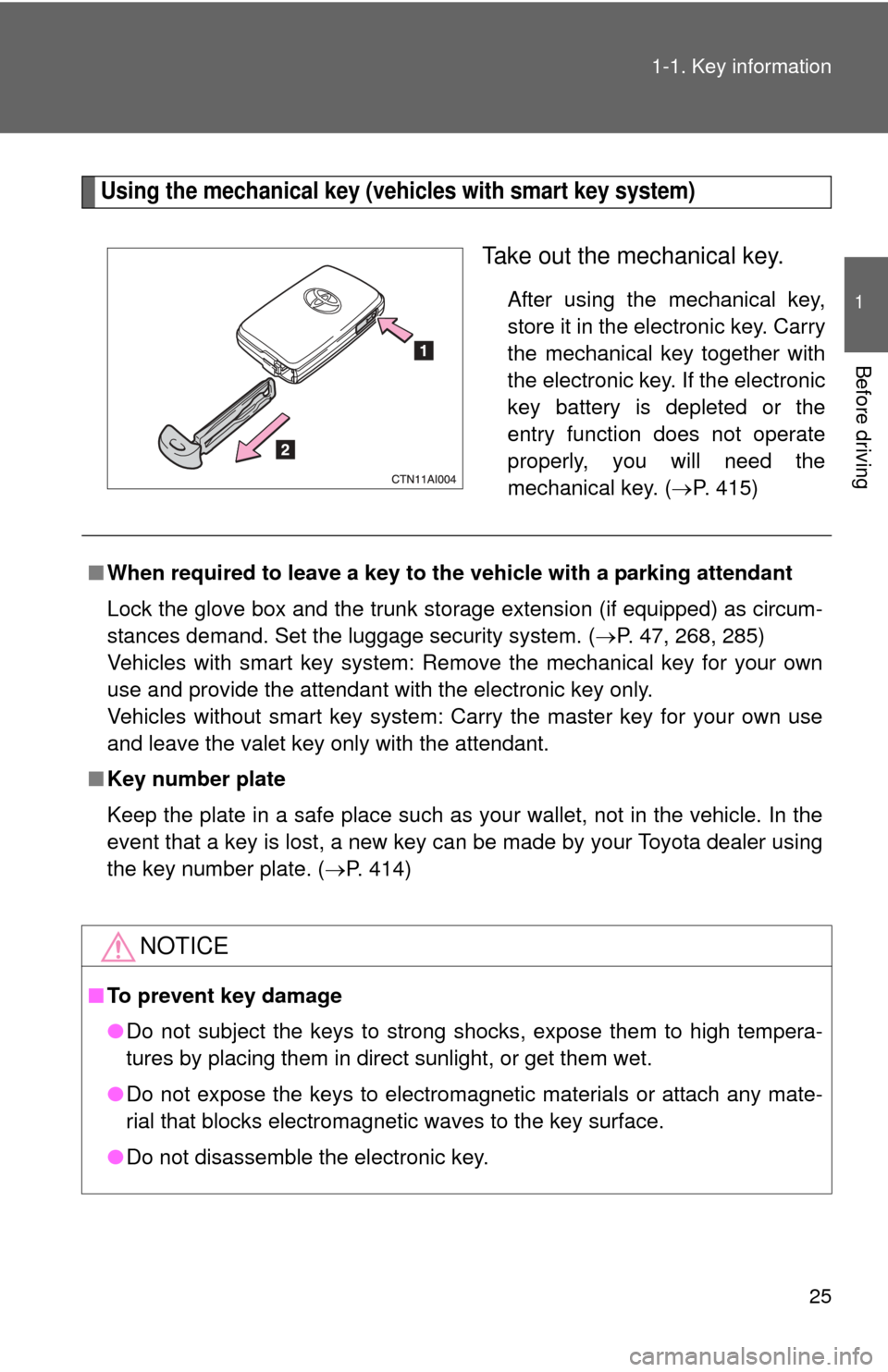2008 TOYOTA CAMRY Vent
[x] Cancel search: VentPage 2 of 476

TABLE OF CONTENTSIndex
2
1-1. Key information .................. 24Keys ..................................... 24
1-2. Opening, closing and locking the doors and
trunk .................................. 26
Smart key system................. 26
Wireless remote control ....... 37
Doors.................................... 41
Trunk .................................... 46
1-3. Adjustable components (seats, mirrors,
steering wheel) ................. 49
Front seats ........................... 49
Rear seats ............................ 51
Head restraints ..................... 53
Seat belts ............................. 55
Steering wheel ..................... 63
Anti-glare inside rear view mirror .................................. 64
Outside rear view mirrors ..... 66
1-4. Opening and closing the windows ............................ 68
Power windows .................... 68
Moon roof ............................. 70
1-5. Refueling ............................. 73 Opening the fuel tank cap .... 73 1-6. Theft deterrent system ....... 77
Engine immobilizer system ................................ 77
Alarm .................................... 79
Theft prevention labels (for U.S.A.) ......................... 81
1-7. Safety information .............. 82 Correct driving posture ......... 82
SRS airbags ......................... 84
Front passenger occupant classification system ........... 96
Child restraint systems ....... 101
Installing child restraints ..... 105
2-1. Driving procedures........... 116 Driving the vehicle .............. 116
Engine (ignition) switch (vehicles with smart key
system) ............................. 126
Engine (ignition) switch (vehicles without smart
key system) ...................... 130
Automatic transmission ...... 133
Manual transmission........... 137
Turn signal lever ................. 138
Parking brake ..................... 139
2-2. Instrument cluster ............ 141 Gauges and meters ............ 141
Indicators and warning lights ................................. 145
Multi-information display ..... 149
1Before driving
2When driving
Page 5 of 476

1
2
3
4
5
6
7
5
5-1. Essential information ....... 374If your vehicle needs to be towed ........................... 374
If you think something is wrong ............................ 377
Fuel pump shut off system .............................. 378
Event data recorder ............ 379
5-2. Steps to take in an emergency ....................... 381
If a warning light turns on or a warning buzzer
sounds... ......................... 381
If a warning message is displayed (vehicles with
multi-information
display) ............................. 391
If you have a flat tire............ 400
If the engine will not start .... 411
If the shift lever cannot be shifted from P (automatic
transmission) .................... 413
If you lose your keys ........... 414
If the electronic key does not operate properly
(vehicles with smart key
system) ............................. 415
If the battery is discharged ........................ 417
If your vehicle overheats ..... 421
If the vehicle becomes stuck ................................. 424 6-1. Specifications ................... 428
Maintenance data (fuel, oil level, etc.) ........... 428
Fuel information.................. 439
Tire information .................. 442
6-2. Customization................... 454 Customizable features........ 454
6-3. Initialization....................... 458 Items to initialize ................. 458
Reporting safety defects for U.S. owners ................ 460
Abbreviation list ........................ 462
Alphabetical index .................... 463
What to do if... ......................... 473
5When trouble arises6Vehicle specifications
7For U.S. owners
Index
Page 23 of 476

Before driving1
23
1-1. Key information................ 24Keys ................................... 24
1-2. Opening, closing and locking the doors and
trunk ................................ 26
Smart key system .............. 26
Wireless remote control ..... 37
Doors ................................. 41
Trunk .................................. 46
1-3. Adjustable components (seats, mirrors,
steering wheel)............... 49
Front seats ......................... 49
Rear seats.......................... 51
Head restraints................... 53
Seat belts ........................... 55
Steering wheel ................... 63
Anti-glare inside rear view mirror ............................... 64
Outside rear view mirrors ... 66 1-4. Opening and closing the
windows.......................... 68
Power windows .................. 68
Moon roof ........................... 70
1-5. Refueling........................... 73 Opening the fuel tank cap ................................... 73
1-6. Theft deterrent system .... 77 Engine immobilizer system ............................. 77
Alarm.................................. 79
Theft prevention labels (for U.S.A.) ....................... 81
1-7. Safety information ........... 82 Correct driving posture....... 82
SRS airbags ....................... 84
Front passenger occupant classification system ........ 96
Child restraint systems..... 101
Installing child restraints... 105
Page 25 of 476

25
1-1. Key information
1
Before driving
Using the mechanical key (vehicles with smart key system)
Take out the mechanical key.
After using the mechanical key,
store it in the electronic key. Carry
the mechanical key together with
the electronic key. If the electronic
key battery is depleted or the
entry function does not operate
properly, you will need the
mechanical key. (
P. 415)
■When required to leave a key to th e vehicle with a parking attendant
Lock the glove box and the trunk storage extension (if equipped) as circum-
stances demand. Set the luggage security system. (P. 47, 268, 285)
Vehicles with smart key system: Remove the mechanical key for your own
use and provide the attendant with the electronic key only.
Vehicles without smart key system: Carry the master key for your own use
and leave the valet key only with the attendant.
■ Key number plate
Keep the plate in a safe place such as your wallet, not in the vehicle. In the
event that a key is lost, a new key can be made by your Toyota dealer using
the key number plate. ( P. 414)
NOTICE
■To prevent key damage
●Do not subject the keys to strong shocks, expose them to high tempera-
tures by placing them in direct sunlight, or get them wet.
● Do not expose the keys to electromagnetic materials or attach any mate-
rial that blocks electromagnetic waves to the key surface.
● Do not disassemble the electronic key.
Page 30 of 476

30 1-2. Opening, closing and locking the doors and trunk
■Operation signals
A buzzer sounds and the emergency flashers flash to indicate that the doors
have been locked/unlocked. (Locked: Once; Unlocked: Twice)
■ Conditions affecting operation
The smart key system uses weak radio waves. In the following situations,
the communication between the electronic key and the vehicle may be
affected, preventing the smart key system and wireless remote control from
operating properly. (Ways of coping: P. 415)
● When the electronic key battery is depleted
● Near a TV tower, electric power plant, gas station, radio station, large dis-
play, airport or other facility that generates strong radio waves or electri-
cal noise
● When carrying a portable radio, ce llular phone, cordless phone or other
wireless communication devices
● When the electronic key has come into contact with, or is covered by, a
metallic object
● When multiple electronic keys are in the vicinity
● When carrying or using the electronic key together with the following
devices that emit radio waves
• Another vehicle’s electronic key
• A wireless key that emits radio waves
• Personal computer
● If window tint with a metallic content or metallic objects are attached to
the rear window
Page 32 of 476

32 1-2. Opening, closing and locking the doors and trunk
■Battery-saving function
In the following circumstances, the entry function is disabled in order to pre-
vent the vehicle and electronic key batteries from discharging.
●When the entry function has not been used for 2 weeks or more
● When the electronic key has been left within approximately 7 ft. (2 m) of
the vehicle for 10 minutes or more
The system will resume operation when...
● The vehicle is locked using the door handle lock switch.
● The vehicle is locked/unlocked using the wireless remote control func-
tion. ( P. 3 7 )
● The vehicle is locked/unlocked using the mechanical key. ( P. 415)
■ Electronic key battery depletion
●The standard battery life is 1 to 2 years. (The battery becomes depleted
even if the electronic key is not used.) If the smart key system or the
wireless remote control function does not operate, or the detection area
becomes smaller, the battery may be depleted. Replace the battery when
necessary. ( P. 353)
● To avoid serious deterioration, do not leave the electronic key within 3 ft.
(1 m) of the following electrical appliances.
•TVs
• Personal computers
• Recharging cellular phones or cordless phones
• Table lamps
■ To operate the system properly
Make sure to carry the electronic key when operating the system. Do not get
the electronic key too close to the vehicle when operating the system from
the outside of the vehicle.
Depending on the position and holding condition of the electronic key, the
key may not be detected correctly and the system may not operate properly.
(The alarm may go off accidentally, or the door lock prevention may not func-
tion.)
Page 33 of 476

33
1-2. Opening, closing and locking the doors and trunk
1
Before driving
■
Note for the smart key system
●Even when the electronic key is within the effective range (detection
areas), the system may not operate properly in the following cases.
• The electronic key is too close to the window or outside door handle,
near the ground, or in a high place when the doors are locked or
unlocked.
• The electronic key is near the ground or in a high place, or too close to the rear bumper center when the trunk is unlocked.
• The electronic key is on the instrument panel, package tray, floor, or in the auxiliary box of the driver's side instrument panel or glove box
when the engine is started or “ENGINE START STOP” switch modes
are changed.
● As long as the electronic key is within the effective range, the doors may
be locked or unlocked by anyone.
● Even if the electronic key is not inside the vehicle, it may be possible to
start the engine if the electronic key is near the window.
● The doors may unlock if a large amount of water splashes on the door
handle, such as in the rain or in a car wash. (The doors will automatically
be locked after approximately 60 seconds if the doors are not opened
and closed.)
● Gripping the door handle when wearing a glove may not unlock the door.
● If the wireless remote control is used to lock the doors when the elec-
tronic key is near the vehicle, there is a possibility that the door may not
be unlocked by the entry function. (Use the wireless remote control to
unlock the doors.)
■ When the vehicle is not dr iven for extended periods
To prevent theft of the vehicle, do not leave the electronic key within 6 ft. (2
m) of the vehicle.
■ Security feature
If a door is not opened within approximately 60 seconds after the vehicle is
unlocked, the security feature automatically locks the vehicle again.
■ Alarms and warning indicators
A combination of exterior and interior alarms as well as warning messages
shown on the multi-information display are used to reduce the chance of
vehicle theft and accidents resulting from erroneous operation. Take appro-
priate measures according to the warning message on the multi-information
display. ( P. 391)
Page 42 of 476

42 1-2. Opening, closing and locking the doors and trunk
Locking the front doors from the outside without a keyVehicles with smart key system
The door cannot be locked if the “ENGINE START STOP” switch is
in ACCESSORY or IGNITION ON mode, or the electronic key is
left inside the vehicle.
Depending on the position of the electronic key, the key may not be
detected correctly and the door may be locked.
Vehicles without smart key system
The door cannot be locked if either of the front doors is open and
the key is in the engine switch.
Rear door child-protector lock
The door cannot be opened from
inside the vehicle when the locks
are set.
These locks can be set to prevent
children from opening the rear
doors. Push down on each rear
door switch to lock both rear
doors.
■Inside lock button
Unlocks the door
Locks the door
The front doors can be opened
by pulling the inside handle
even if the lock buttons are in
the lock position.